Contributory members are able to log private notes and comments about each site
Sites Anne T has logged. View this log as a table or view the most recent logs from everyone
Westfield Farm Refuge Stone
Trip No.54 Entry No.1 Date Added: 11th Oct 2017
Site Type: Early Christian Sculptured Stone
Country: Scotland (West Lothian)
Visited: Yes on 30th Sep 2017. My rating: Condition 2 Ambience 2 Access 4

Westfield Farm Refuge Stone submitted by Anne T on 11th Oct 2017. One of the other faces of the stone, where it shows slight traces of damage, presumably from having been toppled and re-erected. If the 1998 excavation report from Historic Scotland is correct, this stone may be prehistoric and associated with a larger prehistoric site, maybe having been reused as a Refuge Stone after the establishment of Torphichen Preceptory.
(View photo, vote or add a comment)
Log Text: Westfield Farm Refuge Stone (possibly prehistoric), West Lothian: Our last day for exploring before heading home, and this was a day we’d set aside during the week to try and find some of the refuge stones associated with Torphichen Preceptory. We didn’t have a detailed map for this area, and didn’t pass a place to buy one, so had to make do with mobile phones and Canmore records.
The Westfield Farm Refuge Stone is situated to the east of Westfield Village, south of the B8047, near a ‘fish food factory’. Driving through Westfield village on the B8028, we turned right onto the B8047 and followed it round a couple of bends and found the factory. Just before the factory, located on a bend, I spotted a sign saying ‘Refuge Stone’, heading off south east through some wasteland.
We managed to park just by the sign, in a small layby which had been used for fly-tipping. Following the very vague footpath through the wooded area, this eventually disappeared and we were left surrounded by birch trees and weeds. Through the shrubbery there was a mound, and peering closer, there was a set of very overgrown steps that had been cut into the bank. Climbing up these, and hunting around some more, we finally spotted this much neglected stone virtually hidden in the weeds. I trod down some of the taller weeds to see the stone more clearly.
A treasure, but one hidden away in a tumble of brambles, nettles and detritus. It looked as if no-one had visited this stone in a long time. I was very pleased to have found it.
Craigneich Farm
Trip No.53 Entry No.7 Date Added: 11th Oct 2017
Site Type: Standing Stone (Menhir)
Country: Scotland (Perth and Kinross)
Visited: Yes on 11th Oct 2017. My rating: Condition 3 Ambience 3 Access 5
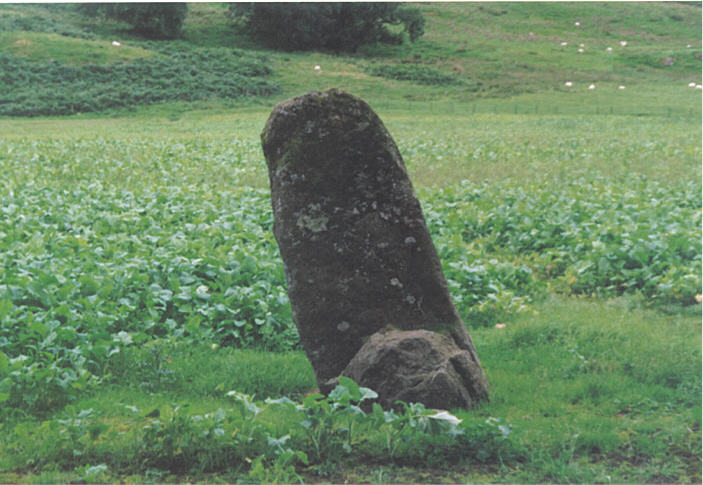
Craigneich Farm submitted by hamish on 26th Jul 2005. This stone is easily seen from the roadside.
(View photo, vote or add a comment)
Log Text: Craigneich Farm Standing Stone, south of Comrie: From the Lawers Standing Stone, we drove south back through Comrie on the B827, to the junction of a minor road at Coilcambus with a phone box on the corner. Turning right (travelling south), we followed the road along to where Machany Water ran close to the road, just before Craigneich Farm. There was a track leading up to the moors on the opposite side of the road, and on this single track road, we needed to pull the car into this entrance for a few minutes while we looked for the stone. We had to climb over wall into field, but the stone wall was low and the wiring broken, so it was easy to access the field.
A somewhat neglected stone, separated from those on the moorland to the south by the road and hedges, it was oddly shaped. By now it was dusk, and I had to use the flash on the camera to get a decent photograph. Worth stopping to have a look.
There were other standing stones which we could see up on the moor to the south, but it was too late in the day to walk up to these and back as it would have been dark by the time we reached the first one.
St Fillan's Chapel (Comrie)
Trip No.53 Entry No.5 Date Added: 11th Oct 2017
Site Type: Ancient Cross
Country: Scotland (Perth and Kinross)
Visited: Yes on 28th Sep 2017. My rating: Condition 2 Ambience 4 Access 4

St Fillan's Chapel (Comrie) submitted by Anne T on 11th Oct 2017. The cross slab, lying just to the south of the south wall of the chapel. In 2014 it was found recumbent but, comparing photographs with the Canmore page (24872), it has now been stood upright.
(View photo, vote or add a comment)
Log Text: St. Fillan's Chapel, west of Comrie: From Wester Tullybannocher Stone Circle, we carried on west along the A85, turning left into a road leading down to St. Fillan’s Golf Club and Western Dundurn Farm. Just before the farm buildings, the track splits. The eastern most track is gated off, and the road was very narrow, so we squeezed the car in by the gate intending to run back and move it if it got in the way. There was a herd of cattle in the field, although the churchyard has a dry stone wall around it.
Walking along the track, watched curiously by the golfers on the adjacent course, until I was level with the church ruins (very like Logie Old Kirk), then squidged my way through the wet turf to the far side, where the iron gate to the churchyard was locked, but there was a stone stile into the graveyard.
This is a very, very pretty spot. It is a very old site. Typically, there was no phone signal here so I couldn’t call up the Canmore record. I went round photographing lots of different things. I managed to miss the recumbent cross slab (most of them were overgrown with grass), although there were a couple of other interesting stones and features. Lovely site but disappointing not to have found the cross slab, even though I must have looked at it.
Also known as St Fillian's; Dundurn Burial-ground; Stewarts Of Ardvoirlich Burial-place.
Tullybannocher
Trip No.53 Entry No.4 Date Added: 11th Oct 2017
Site Type: Stone Circle
Country: Scotland (Perth and Kinross)
Visited: Yes on 28th Sep 2017. My rating: Condition 3 Ambience 4 Access 4
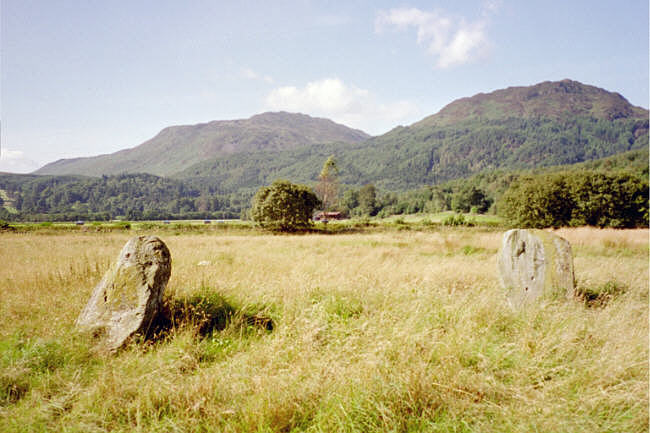
Tullybannocher submitted by hamish on 23rd Jul 2005. It's easy to miss this one, I stopped in a field gateway to look at the map glanced round and there it was in that field. It was a four poster by repute but only two remain. Nick thinks there are cupmarks on the stones but not so sure myself.
(View photo, vote or add a comment)
Log Text: Wester Tullybannocher Stone Circle, Comrie: From the Dalginross/Dunmoid Four Poster Stone Circle, we made our way north through Comrie, heading west on the A85, over Dalginross Bridge then turning left. The road goes through a zig-zag then a bend, passing a caravan park on the right hand side at Twenty Shilling Wood. Just after the road turns a right hand bend there is a farm track to your right hand side, with room for a car to pull in before the gate (on opening the gate there is a small area of hard-standing for a couple of cars). We parked just in front of the gate and walked along the farm track to the stones, which were peeping out of knee high grass in the un cultivated part of the field to our left hand side.
We couldn’t spot any cup marks on the western stone, despite walking round the stones several times. Sited on flat pastureland with low hills rising around, and lying just north of the River Earn, this is a lovely spot, although a little spoiled by the heavy traffic on the A85 just to the south of the stones.
Dalginross
Trip No.53 Entry No.3 Date Added: 10th Oct 2017
Site Type: Stone Circle
Country: Scotland (Perth and Kinross)
Visited: Yes on 28th Sep 2017. My rating: Condition 3 Ambience 4 Access 5
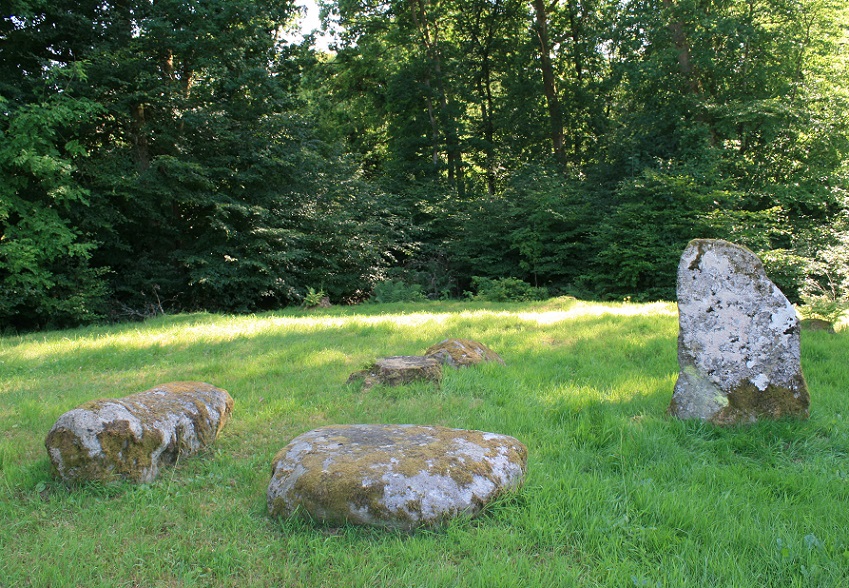
Dalginross submitted by postman on 13th Aug 2013. Peace and quiet, some cars may have gone past, but I didn't notice them.
(View photo, vote or add a comment)
Log Text: Dalginross Four Poster, Near Comrie: From the Roman Stone and its companions, we headed north towards Comrie. Where the B827 takes a sharp left hand turn through Dalginross and Comrie, take the South Crieff Road towards Easter Dalginross and Muirhead Cemetery, where there is ample parking.
From the layby by the cemetery, we walked back to the road junction with South Crieff Road and the trck to Dalginross Muir Farm; the stone circle is nestled under the trees, with moss covered tree stumps around it.
Quite an enigmatic little stone circle, but I confess that it seemed a little like it had been recently put in here, perhaps as a landscaping feature. I had a bit of a hard time convincing myself it was Bronze Age, but Canmore confirms it is indeed.
West Cowden
Trip No.52 Entry No.2 Date Added: 10th Oct 2017
Site Type: Stone Row / Alignment
Country: Scotland (Perth and Kinross)
Visited: Yes on 28th Sep 2017. My rating: Condition 2 Ambience 3 Access 5
West Cowden submitted by cosmic on 23rd Jun 2006. Roman Stone from South.
(View photo, vote or add a comment)
Log Text: The Roman Stone, Comrie: Approaching Comrie from the south along the B827, we’d passed these stones at the eastern side of the road before we’d realised it, so ended up stopping for lunch and visiting the motte first. We retraced our steps and managed to park in the entrance to another (gated) track opposite.
These stones are also known as the Dalginross; Penfillan and West Cowden Farm stones, although they are called the Roman Stones on the OS map. Not in the greatest location, but the track alongside the stones made it easy to walk round the stones and photograph them, although I got a few stares from passing drivers as I did so!
The cup marks were pretty easy to spot, once the sunlight changed a little, although I thought I saw these on the top of the Roman Stone itself; the 1911 entry talks about an 18 inch high stone with 22 cups. I photographed all three stones and the only cup marks we both thought we saw were five on the southern face of the Roman stone itself (the largest stone).
Coney Hill (Comrie)
Trip No.53 Entry No.1 Date Added: 10th Oct 2017
Site Type: Misc. Earthwork
Country: Scotland (Perth and Kinross)
Visited: Yes on 28th Sep 2017. My rating: Condition 2 Ambience 2 Access 4
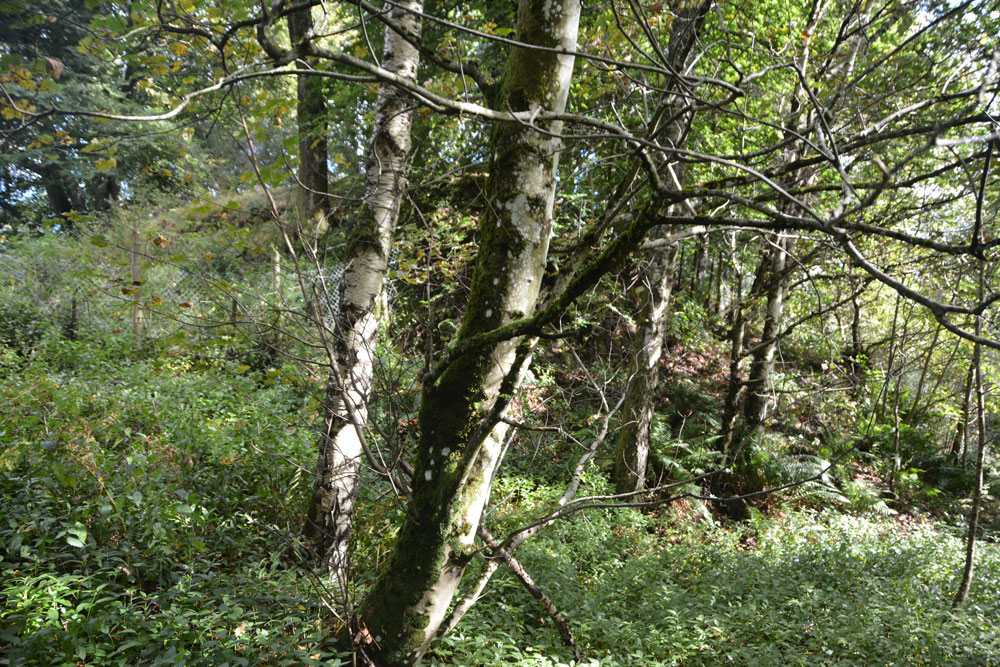
Coney Hill (Comrie) submitted by Anne T on 10th Oct 2017. From the path along the east side of the River Lednock, looking up, the mound of the motte is barely visible through the trees.
(View photo, vote or add a comment)
Log Text: Coney Hill, Comrie: Again, to escape the dreary weather in Armadale, we found ourselves heading a fair way north today, up to Comrie, where there promised to be quite a few sites – standing stones and stone circles in a relatively small area.
Comrie is a really lovely little village, and we stopped for tea and a sandwich at one of the café’s. The menu didn’t appeal to me, so I got a hot Scotch Pie from the next door bakers – one of the best I’d ever tasted.
We didn’t plan on going to this motte, but having walked up the high street and over the bridges, carried on onto the walks which were signposted. There was a large car park next to the golf course.. It had rained here heavily and the paths up to the motte were muddy and slipperty, with a steep drop down to the River Lednock below. The motte was so heavily surrounded by trees that it was difficult to make out by eye, and even more difficult to photograph.
The Chesters
Trip No.52 Entry No.8 Date Added: 10th Oct 2017
Site Type: Hillfort
Country: Scotland (East Lothian)
Visited: Yes on 27th Sep 2017. My rating: Condition 3 Ambience 4 Access 4

The Chesters submitted by uisdean on 1st May 2008. Southerly ramparts of The Chesters. The hill overlooking the fort can be seen rising to the left of the picture.
(View photo, vote or add a comment)
Log Text: The Chesters Hillfort, East Lothian: Most places we drove past today had signposts to The Chesters, so reluctant to go back to the house before dark, we decided to stop off and look at this hillfort, which I thought must have been visited by many other Portal users/members, but only uisdean has submitted photographs – I was very surprised.
There is a small car park near Dalvreck Farm House, with a signposted walk through (at this time of the evening) a dark wood. This opens out into a meadow, which has tall wire fences all around it, “to prevent rabbit damage”, and to my horror, a very tall stile leading over another fence into the fort itself.
Actually, this stile was one of the easiest I’ve ever used to get over, as it had supports at the top to let me stand upright and feel balanced and secure, before clambering down the other side.
This is certainly a complex site. I was fascinated by a large boulder to the east of the site, and there is also an unknown part of the meadow to the north.
We tramped around, enjoying the quiet and the complexity of the site, until dusk fell really heavily and we decided it was time to go back and have something to eat.
White Castle Fort
Trip No.52 Entry No.7 Date Added: 10th Oct 2017
Site Type: Hillfort
Country: Scotland (East Lothian)
Visited: Yes on 27th Sep 2017. My rating: Condition 3 Ambience 4 Access 5
White Castle Fort submitted by cosmic on 30th May 2008. Site in West Lothian:
Janet in first ditch
(View photo, vote or add a comment)
Log Text: White Castle Hillfort, East Lothian: This is in a wild and lonely spot. As we approached the hillfort, the mist started to roll in over the Thorter Burn Valley, the wind got up and whipped spots of rain across our faces.
I was amazed to be able to park right by the gate, where there were interpretation boards. Mind you, someone had left a pile of rubbish just inside the gate, which was horrible.
The ramparts to the south/west side of the fort are so crisp and clear, they could have been dug yesterday. The views down Thorter Burn valley were great, and to some extent the fort was protected by the hillside to the south.
We did see some evidence of disturbance on the top of the hillfort, together with what looked like an not-very defined house/structure to the northern side of the oval top of the fort. After being almost blown off the top of the hill, we decided on one last stop before heading back to Armadale for the night.
Standingstone (East Lothian)
Trip No.52 Entry No.5 Date Added: 10th Oct 2017
Site Type: Standing Stone (Menhir)
Country: Scotland (East Lothian)
Visited: Yes on 27th Sep 2017. My rating: Condition 3 Ambience 4 Access 5
Standingstone (East Lothian) submitted by cosmic on 31st May 2008.
Viewed from South
(View photo, vote or add a comment)
Log Text: Standingstone Standing Stone, East Lothian: As we pulled up outside the Standingstone farm house, a lady and her black pug came out of the farmyard. I apologised for turning up out of the blue, but did she know about the standing stone, and she said ‘yes’, asked if I knew where it was, and walked us to it. It was in a little orchard, behind the adjacent cottage. There were glacial striations on the stone, now vertical as the stone had been stood upright.
When talking about the hillfort above us (Tarprain Law) she said “the chieftain was supposed to have thrown his daughter off the top, for falling in love with someone she shouldn’t have. She was supposed to have turned into a robin. The strange thing about here is that we have hundreds and hundreds of robins, and they are here all year. Weird.” She gave a shiver. She told me we were supposed to hug the standing stones.
Loth Stone
Trip No.52 Entry No.6 Date Added: 10th Oct 2017
Site Type: Standing Stone (Menhir)
Country: Scotland (East Lothian)
Visited: Yes on 27th Sep 2017. My rating: Condition 3 Ambience 4 Access 4
Loth Stone submitted by minteddy on 14th Dec 2006. Cairndinnis Farm: Loth Stone. The stone is on the edge of a bridleway on south south west side of Traprain Law. The photograph was taken in autumn 1991. I had the impression from somewhere that the current position of the stone is not original. Has it been moved? I assume Loth must have been some chieftain or king after which the Lothian counties are named.
(View photo, vote or add a comment)
Log Text: The Loth Stone, west of Traprain Law hillfort: Just up the hill from Standingstone Farm, up a lovely grassy lane just to the west of Traprain Law hillfort. The stone has now been moved against a hedge. There is a small gate into the field, where the wheat had just been harvested, letting us walk right up to the stone and photograph it.
We did peer around the field hoping to see some sign of the cairn at NT 5781 7409, some 53 metres to the south of its current location but could see nothing.
With Traprain Law hillfort rising up to the east, this was a quiet, pleasant and atmospheric spot, although the standing stone did seem a little abandoned. Next stop was to be a hill fort in an even more remote location.
Boar Stone (Drem)
Trip No.52 Entry No.1 Date Added: 9th Oct 2017
Site Type: Ancient Cross
Country: Scotland (East Lothian)
Visited: Yes on 27th Sep 2017. My rating: Condition 3 Ambience 3 Access 5
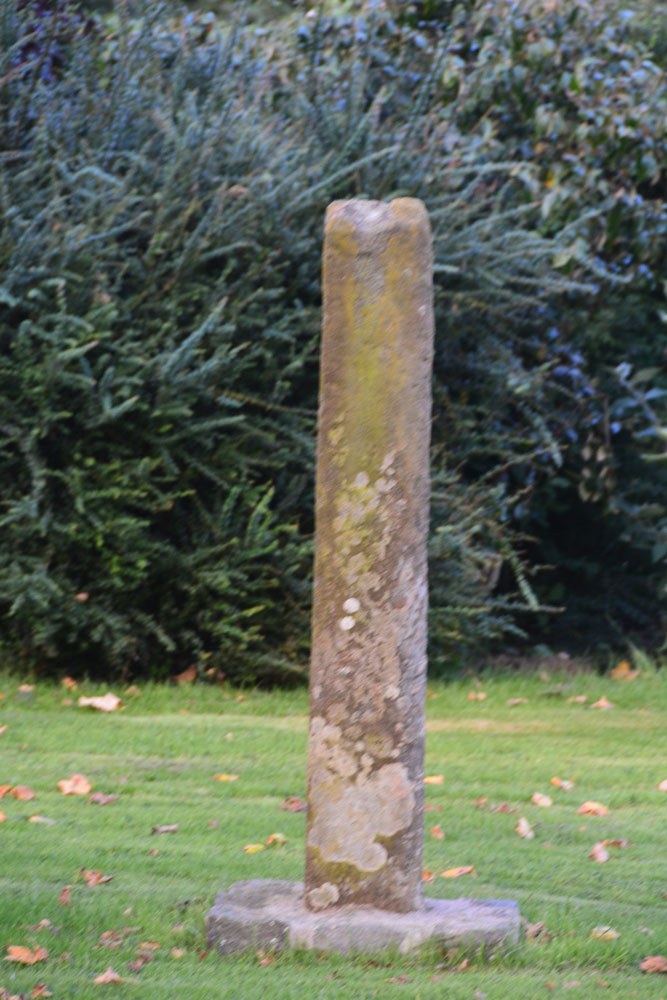
Boar Stone (Drem) submitted by Anne T on 9th Oct 2017. Using the zoom lens on my camera to get a better view of the southern face of this broken, relocated cross shaft.
(View photo, vote or add a comment)
Log Text: The Boar Stone, East of Drem Village: This stone is located to the north side of the B1377, in the garden of Prora Farm, some 1.4 km east of Drem station. It has been relocated from the edge of a field at NT 5280 7924, some 640 metres south south east of its current location.
The right to roam in Scotland does not cover people’s gardens, so I had to be content with walking up and down the width of the garden alongside the B1377, which was very busy, and has the train line running immediately to the south, so not the best spot.
There is no real information on Canmore, apart from the describe it as a cross. There is a link through to the East Lothian Council records, which describes this as “a broken sandstone cross-shaft with chamfered edges, 5ft 11ins high, 1ft 2ins broad and 11 1/2ins thick at the lower end, but tapering to 7 1/4ins in thickness at the upper end”, which comes from the name book of 1853.
Pencraig Brae
Trip No.52 Entry No.2 Date Added: 9th Oct 2017
Site Type: Standing Stone (Menhir)
Country: Scotland (East Lothian)
Visited: Yes on 27th Sep 2017. My rating: Condition 3 Ambience 4 Access 4
Pencraig Brae submitted by minteddy on 14th Dec 2006. Pencraig Hill. This is a tall standing stone (about 3 metres?) in a field to the north of A1. This has now been by-passed by the new dual carriageway.
(View photo, vote or add a comment)
Log Text: Pencraig Hill Standing Stone, East Lothian: Standing just north of the A199, Pencraig Brae Road. There was room to pull the car onto the grass verge next to the tumble-down gate into the field, which we managed to squeeze our way round the edge, as it hadn’t been opened in many a year.
The field was planted with mature cabbages, with the farmer and a small team harvesting a couple of hundred yards to the west. There was sufficient space between the rows of cabbages to pick our way very carefully up to the stone and photograph it. The workers didn’t seem to mind us, as they could see us taking care in picking our route.
A tall, fine standing stone, and one I’m glad to have seen. Despite the cabbages, this was a lovely location and an atmospheric stone.
Logie Old Kirk (Stirling)
Trip No.51 Entry No.2 Date Added: 9th Oct 2017
Site Type: Early Christian Sculptured Stone
Country: Scotland (Stirling)
Visited: Yes on 26th Sep 2017. My rating: Condition 3 Ambience 4 Access 4
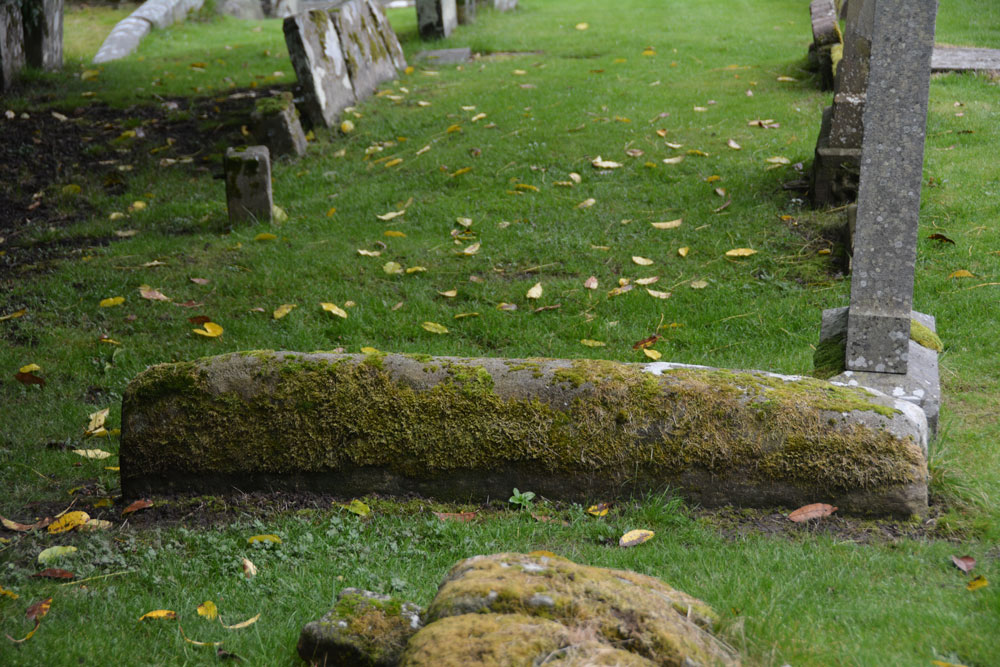
Logie Old Kirk (Stirling) submitted by Anne T on 9th Oct 2017. The hogback as seen from its northern side. Just to its north of this stone is a collection of broken stones, orientated north-south which look like another broken up hogback, but nothing is mentioned by Canmore.
(View photo, vote or add a comment)
Log Text: Hogbacks at Logie Old Kirk, Stirling: To reach the church from the University Halls of Residence, we had to walk through the gardener’s compound/offices. The top two gates around the churchyard were locked; the actual entrance was next to the small stone building to the south of the churchyard, near the stream, with an information board by a small car park, so there is access from the main road.
The churchyard is full of wonderful (morbid!) tombstones. Could have spent the day photographing them. It was also a lovely location with a small stream trickling along the eastern side of the churchyard.
Found one hogback SE of the church, the second is just a lump at the end (by the church) of the 6th row of graves, counting from the stream at the east end of the churchyard. A wonderful location. Really could have spent hours here.
Pathfoot Stone
Trip No.51 Entry No.3 Date Added: 9th Oct 2017
Site Type: Standing Stone (Menhir)
Country: Scotland (Stirling)
Visited: Yes on 26th Sep 2017. My rating: Condition 2 Ambience 3 Access 5

Pathfoot Stone submitted by rogerkread on 14th Oct 2015. Side view.
(View photo, vote or add a comment)
Log Text: Pathfoot Standing Stone, University of Stirling: Walking back across the campus from Logie Old Church, we got caught in a very heavy shower of rain and had to shelter by the student residences at the western side of the campus.
When I caught sight of this, I thought this was a sculpture, not a real standing stone at first. It is at the side of Armitage Road, just north of its’ (busy) junction with Grange Road at the north western side of the campus. We clambered up the wet, slippery slope to take some photos, stared at by the passing students.
By this time, my feet were aching, as we’d spent the best part of 2 hours walking round and round the campus. With Stirling Castle still to come, I welcomed getting back into the car.
Airthrey Stone
Trip No.51 Entry No.1 Date Added: 9th Oct 2017
Site Type: Standing Stone (Menhir)
Country: Scotland (Stirling)
Visited: Yes on 26th Sep 2017. My rating: Condition 4 Ambience 4 Access 3
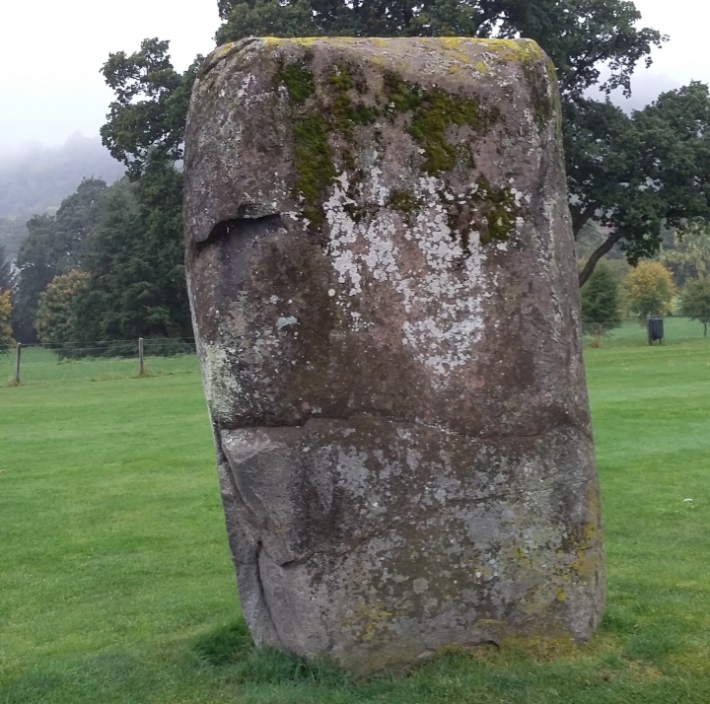
Airthrey Stone submitted by rogerkread on 16th Oct 2015. The Northern face of the Airthrey Stone.
(View photo, vote or add a comment)
Log Text: Airthrey Castle Standing Stone, Stirling University: I have visited the University of Stirling on a number of occasions over the years, visiting an organisation at the Beta Innovation Park, but not known (until I saw them on the Portal) that there were standing stones within the grounds.
We parked at the Wallace Monument, thinking it would be quick half hour walk around Stirling University Campus. Wrong! From the car park, we walked east up Hillfoots Road (the B989) cutting into the Alpha Centre Innovation Park, then walking round the east side of the lake to the University Sports Ground.
As soon as we reached the fence into this area, this huge standing stone stood out. I found the stiles a little too high for my dodgy knees, so it was interesting getting over them!
The surrounding hills, and the view back to the Wallace Monument make this an interesting spot. There were lots of dog walkers and students around, but none seemed to take any notice of the stone – presumably they are all familiar with it. By the time we’d visited Logie Old Church and the Pathfoot Standing Stone, my feet were aching! But no time to relax – Stirling Castle called with a loud, clear voice!
Acholter
Trip No.50 Entry No.6 Date Added: 9th Oct 2017
Site Type: Standing Stone (Menhir)
Country: Scotland (Isle of Bute)
Visited: Yes on 25th Sep 2017. My rating: Condition 3 Ambience 3 Access 4

Acholter submitted by Anne T on 9th Oct 2017. This was about as close as we could get to this standing stone (about 8-10 metres). The field was absolutely sodden in water and the cow pats were ankle deep. We cut our losses and took photographs as best we could through the thickening mist.
(View photo, vote or add a comment)
Log Text: Acholter Standing Stone, Isle of Bute: From the Scalpsie Bronze Age Barrow, we headed north up the A844 towards Colmac and East Colmac to see the stone circle, a standing stone with incised cross and an earthwork. By this time, we were starting to run out of time as we needed to get back to Rounsay for the ferry.
There had just been an accident at the southern end of Ettrick Bay – a camper van and a car had gone head on into each other at low speed. All the occupants of the vehicles were out on the roadside and others had stopped to help. I can imagine turning the corner of the A844 and coming onto this lovely stretch of sand and sea, not looking where you were going properly. We followed the line of cars past them. I spotted this standing stone on the map. We weren’t going to stop, but the stone was visible through the mist in the field, so we pulled up by the side of the road.
My goodness, the entrances to the fields were ankle deep in water, so we walked further south to another field gate and used an alternative route. The whole field was so very wet and absolutely covered in damp, smelly cow pats, that we could only get within about 10 metres of the stone. By this time, the mist really was so bad we could hardly see the stone.
Picking our way back to the road, me with very wet socks and shoes, I turned back to the field only to see a herd of large cows making their way towards us. Where had they come from? We didn’t see them in the field, and they made an eerie sight through the mist!
Scalpsie Barrow
Trip No.50 Entry No.5 Date Added: 9th Oct 2017
Site Type: Round Cairn
Country: Scotland (Isle of Bute)
Visited: Yes on 25th Sep 2017. My rating: Condition 3 Ambience 3 Access 5

Scalpsie Barrow submitted by durhamnature on 23rd Sep 2012. Photo of barrow, from "The book of Arran" by J A Balfour 1910 via archive.org
Site in Isle of Bute Scotland
(View photo, vote or add a comment)
Log Text: Scalpsie Barrow, Isle of Bute: We didn’t plan to stop here, but there was a car park and information board by the field alongside the A844 past Ambrismore on the way to Ardscalpsie, signposted to the beach, so we screeched to a halt to explore. The information board differentiated between the barrow and another cairn, also somewhere in the field, but the fog was so bad, we couldn’t see it, and it was very difficult to photograph the main barrow.!
Worth stopping to see. The gate into the field was about 100 metres further west along the road from the small car park. Walking back to the barrow, my feet got completely drenched. A shame the fog was so bad, as I’d have loved to have found the second cairn.
Blackpark
Trip No.50 Entry No.4 Date Added: 9th Oct 2017
Site Type: Stone Circle
Country: Scotland (Isle of Bute)
Visited: Yes on 25th Sep 2017. My rating: Condition 3 Ambience 4 Access 4

Blackpark Stone Circle submitted by saille on 14th Jan 2004. At NS 091556, the stone circle in Blackpark Plantation has only three stones left standing, the remains of a larger complex of seven stones.
Now surrounded by forestry plantation.
Towards the west of the road, between Kingarth and Largizean farm, there are three more standing stones which are more in-line with each other than Blackpark.
(View photo, vote or add a comment)
Log Text: Blackpart Standing Stone, Isle of Bute: About 2.3 km north of St. Blane’s Chapel, still on Plan Road. There is a small car park just off the road, north of the stones, at NS 09160 55716. The ground was very boggy, with large pools of water both on the path to them and in between, so we had to pick our way very careful.
These three stones are some of the most mis-matched I’ve seen. The northern and southern most stones are made of a reddish conglomerate, a little like cement. The third stone looks like whinstone, which has split down the middle, and is the oddest of shapes, morphing what it looks like completely as you walk around it.
Thankfully the mist had thinned by the time we arrived here, and the sun was just starting to show throw the pine trees of the surrounding forest.
I was very intrigued by the southernmost stone, on a mound – is this a cairn? No mention of this on Canmore, although as I was walking around it I spotted graffiti, including what looked like a misshapen cross.
St Blane's Chapel (Isle of Bute)
Trip No.51 Entry No.3 Date Added: 8th Oct 2017
Site Type: Ancient Cross
Country: Scotland (Isle of Bute)
Visited: Yes
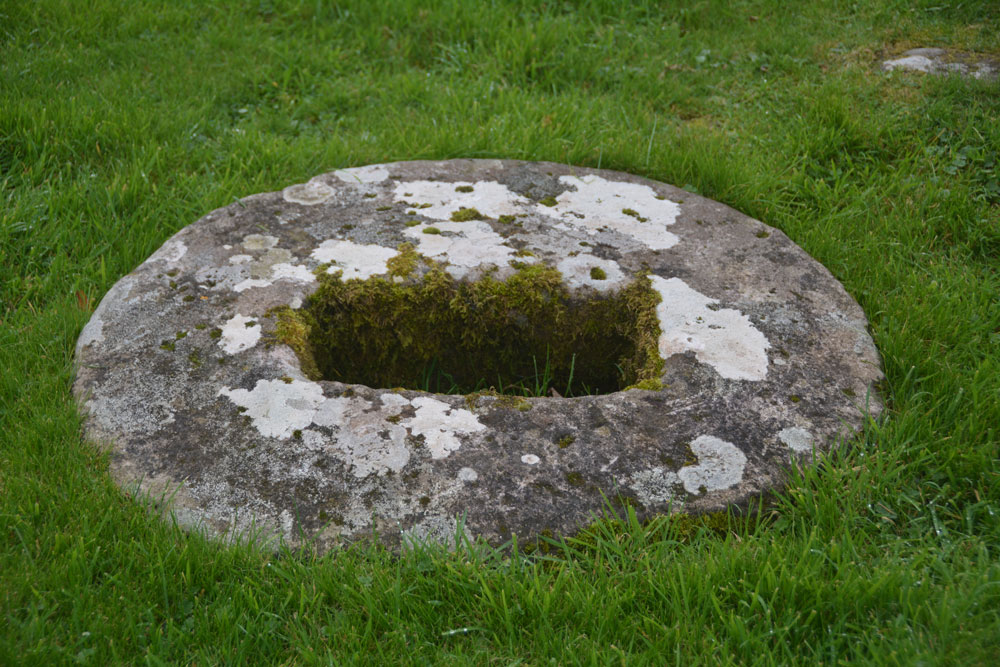
St Blane's Chapel (Isle of Bute) submitted by Anne T on 8th Oct 2017. This cross-base/socket stone is embedded within the ground in the lower (southern part) of the graveyard. There is apparently another cross base 70m north of the chancel, although we were unable to find this.
(View photo, vote or add a comment)
Log Text: Cross base/socket stone, St. Blane's Chapel, Isle of Bute: Whilst I was wandering through the ruins of the chapel and photographing it, husband Andrew was in search of this sandstone socket in the lower churchyard. In the end, it was easy to find – head south out of the ruins, into the upper churchyard, down the steps, and it is virtually in front of you to your left hand side. I confess that without the Canmore record, I might have very well missed this, as I’m used to seeing socket stones that are sitting on the ground, not buried within it.
